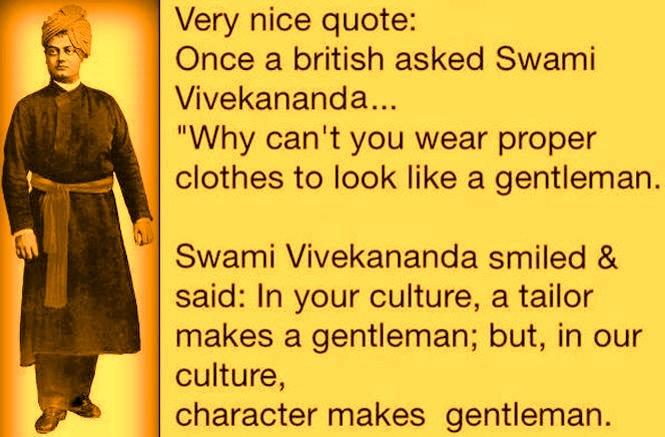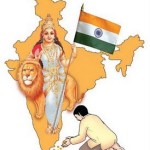“How regressive!”, they may say. “MGTOW!” they will retort. “Tactic to guilt women into becoming Ladies!”, they might argue. Yes, even the last one is true courtesy feminists in our topsy turvy age. But the reality is, whatever radfem activists argue, whatever redpill [do]tards retort, and whatever post-modern popinjays might protest, for a civilised society, Gentlemen not only Matter but are, in fact, Foundational.
Pickup/Seduction artists may protest that “nice guys finish last” and “girls like bad boys”—and incidentally, I’m not actually contesting your point. But the problem is, you’re not asking why it might be true. The reason why nice guys finish last & many (not all) girls like bad boys is because when most people lead boring lives, it’s natural to want a little excitement, even if it is stupid or even dangerous. But none of this means a gentleman has to be boring. None of this means a gentleman can’t deliver a good ass-kicking to bad boys. And none of this means a gentleman can’t be popular with the ladies as well.
Mera rath par tumhara swagat hai, Rajkumari
And this is precisely the problem. Most young men forget that in a world dominated by bad boys, the Niti of Krishna is required. The attitude of bad boys (most of whom are usually cowards with attitude) is misconstrued as confidence and strength and excitement. That’s why nice guys finish last. If you still look like your mummy picks your outfits, why would any girl want you?
But this is the conundrum, the false dichotomy if you will, in a long line of confused bipolarity facing modern society. Boring Nice guy vs Bad boy, Libertinism vs Slavery, Communism vs Capitalism, and of course, that all time classic, Virgin vs Whore. The Madonna-Magdalene dichotomy is one of the most injurious to civilised society, and yes, even one that prizes chastity. Simply because a woman is not “Mary-mother-of Jesus” or Sita Devi, does not mean it is “open season”.
I have used these two examples because contrary to attempts by Western Academia and Mainstream Media, it is not just Indian society that faces an issue with exploitation of women. In fact it is far, far worse in the Developed World , East Asia, and the Middle East. The difference is, unlike “Modern/Secular/Capitalist” India, Traditional Ancient Dharmic India emphasised the dignity of a woman, no matter who she was. And there were brutal consequences for men who tried to violate it (Google: Dushasana).
Our society even works law of dharma. Not contract based civil law. Thats why we have just 12800 police stations for 6.7 lac villages/towns
— S Gurumurthy (@sgurumurthy) November 14, 2015
As is now well known, Kalidasa‘s Raghuvamsa described how safe the city of Ayodhya was for women:
Yasmin maheem shaasathi vaaneenaam nidhraam vihaaraardhapathe gathaanaam |
vaatho’pi naasraam-sayada-sukaani ko lambayed aaharanaaya hastham || (S. 6,sl.75)
While he [Dilipa ancestor of Rama] was ruler of the earth, even the very breeze dared not disturb the skirts of drunken women who sank to sleep on the road when half-way they had strayed to the place of enjoyment; far less dared any one to extend his hand for theft. [1,115]
We are of course a long ways away from Ram Raj, and modern India has its issues. But Crime occurs in any society, and statistics demonstrate that.
Why is only India targeted via “India’s Daughter” and other such politically-motivated documentaries? After all, all is not healthy in the infallible West. What of this culture?
 This is the danger of racial stereotyping and negative imaging. Narratives are invented and individuals are judged on the basis of pre-conceived notions (usually by the ignorant). Unlike the intellectually dishonest doyennes of the Western Ivory Tower, we won’t stereotype this as emblematic of Western culture, despite the historically confirmed misogynist reputation of a certain “Universal” Institution that happens to be the world’s oldest bureaucracy. The fact is, there is an even deeper sickness, and that is called post-modernity.
This is the danger of racial stereotyping and negative imaging. Narratives are invented and individuals are judged on the basis of pre-conceived notions (usually by the ignorant). Unlike the intellectually dishonest doyennes of the Western Ivory Tower, we won’t stereotype this as emblematic of Western culture, despite the historically confirmed misogynist reputation of a certain “Universal” Institution that happens to be the world’s oldest bureaucracy. The fact is, there is an even deeper sickness, and that is called post-modernity.
If Post-Modern Society is a Bastard Society, is it any wonder there are few gentlemen anymore, in any part of the world? Yes, much like boys complain, nice guys are finishing last (so women do have some part of the blame), but the time has come to put an end to the Virgin-Whore dichotomy. This is damaging not only to the vast majority of women who are in the middle (just like the vast majority of men), but is damaging to society as well, as it degrades the dignity of all women.
Sita Mata once asserted the unfairness of all women being judged by the behaviour of a few vulgar women. And this is true. That is the reason why we split character into three parts.
Character is 3 parts:
1.Moral Character (living according to Moral Standards, religious, sexual, etc)
2.Personal Integrity (holding true to your obligations, beliefs, and promises)
3.Ethical Civility (treating other with respect and acting for societal good)
If we ask how many men have what it takes to be Ram, isn’t the corollary how many women have what it takes to be Sita?
Contrary to absinthe-addicted activists, if you have no loyalty to your own society “because patriarchy!”, don’t expect to not be civilly criticised for your ridiculous views. And for those ritualistic twenty something twits on twitter who say “We are not Sri Rama to treat Surpanakha with respect”—well dear ritualistic twenty something twit on twitter, then don’t expect to marry a woman who is like Sita either. Whether you believe in probability or divinity, we get in life (generally) what we ourselves deserve.
As such, whether it is the reprehensible behaviour of members of that so called “Secular” Political Party AAP, or the corporate culture of that American Jewelry corporation, one can see how the absence of gentlemen creates conditions for the exploitation of women—whatever the rule of law.
Bad boys are “bad” for a reason, ladies. No matter how they look, no matter what they say, what’s important is how they see…you. But these scenarios also show that it is not a simple matter of a “chaste religious girl” vs “office floozy”. If most men are of middling character, so too are most women. And as we illustrated, character is more than just moral character, it is also strength of belief and willingness to endure (even in the face of hardship or authority).

This is the importance of Sabhyata, Saujanya, & Maryada. All of these are an integral part of Nara Dharma. It is also why Bhagvan Ram was called Maryada Purushottam. It didn’t matter whether it she was Sita or Surpanakha, Rama treated all women with respect. It is only when Surpanakha threatened to kill Sita that Rama had Lakshmana punish her.
A man behaves like a gentleman not because of what it says about her, but because of what it says about him.
The American jewelry store chain had many more women whose maternal or economic or office hierarchical cares kicked in allowing their vulnerability to be exploited by bad men. There was probably a small percentage of vulgar women who were delighted to go along with the advances of men—but even if it was as much as 33%, that means still 67% didn’t want to and were pressured by these American men who should have treated their colleagues and employees with respect. Some may say the middling 33% submitted to this pressure probably just found an excuse—but to that, the answer is “who’s to say?”. Do you have student loan debt you can’t pay if you lose your job? Do you have a parent whose life depends on expensive medical care? Are you a single mother with a child to feed?
That last one Should sound familiar.
Most guys may say “Really? Problem solved, and I get sex too?” and most social contract sybarites may attest “It is simply a transaction resulting mutual gain“, but then society doesn’t judge men and women the same way in matters of sex, so neither judgmental men nor their feminist/objectivist analogues have it right. Others may then argue “well, there were women who resist even that pressure”—and to that I say yes. There were women who resisted and there are women who resist. But both women and men are subject to blackmail, it’s just that they are usually blackmailed for different things. The women and men of highest character resist blackmail even in the face of dire circumstances, but also in the case of authority.
The story of Ahalya is illustrative here:
Most people believe that Ahalya was fooled by Indra into thinking he was her husband Gautama, and that is why she had physical relations with him. But as the Valmiki Ramayana itself confirms, Ahalya was in fact very clever, and was intelligent enough to realize it wasn’t her husband. So why then did she agree? Well, most men have a ready answer and claim all women are like this when they get the chance. But that is not actually the case. Ahalya agreed to the tryst because in her respect for authority she believed a Brahmin or King or King of the Gods could not be disobeyed. But this of course is not Dharma, as we know Ravana who was a brahmin & a king & defeated the King of the Gods, was rightly refused. Authority, whether that of a brahmin, a king, or deva cannot be misused to exploit a person. And as both Indra and Ravana found out, they too would have to be punished and suffer the consequences, whatever their status or position.
That is also why Ahalya was cursed to turn into a stone. Just because in her delicateness woman may be more amenable to authority is no excuse to engage in immorality. She may be delicate like a flower or vine, but when faced with immorality and evil, woman must also be able to turn into a stone—and the men who would devilishly exploit them, must get hit by one.
That is why in the case of Sita we see that she not only turned into a stone (metaphorically speaking), but over the course of a year of torment, seduction attempts, pleading, and threats by Ravana, she became a veritable diamond. That is why both she and her only love, Rama, were described as follows:

Vajradapi katorani mrudooni kusumadapi |
Lokotharaanaam chetaamsi ko nu vigyathu marhaati ||
Harder than a diamond and softer than a flower
Who can gauge the conduct of super-eminent persons?
It is this middle endurance that is lacking in both women AND men today, whether it is morality-obsessed Indian society or decency driven American society.
It is the courage of conviction that allows you to keep your character, even in difficult circumstances. And it is also the absence of gentlemen to intervene when the law fails or even a culture collapses, that creates bastards and the cycle of bastardy.
But as we’ve emphasized, contrary to what MSM, Cultural Anthropologists, and Native informants tell you, this problem is not specific to a specific culture, but as we’ve seen and will see now, an issue that all societies face when they become decadent or immoral.
“The Rape of Lucretia” is a famous episode from Italian History. It is all the more illustrative because the son of the Roman King Tarquinius Superbus threatened her that if she resisted, he would lie and tell everyone she willingly slept with a slave. The bad boys of today of course are even worse because unlike young Tarquin, they would have lied anyway. Nevertheless, it was the rape of Lucretia that caused Roman society to raise arms against the oppression of the Tyrannical Tarquins, and under Lucius Junius Brutus, established the Roman Republic. But the issue here is not the form of government, or even the specific culture, but the state of moral culture in society, especially in its elites.
And for those “human rights activists” who only seem to have Indian culture in their sights with regard to women and misogyny and Agni Pareeksha, tell me again which civilization produced this celebrated figure who said this:
This is the problem with double standards and selective application. Justice for my friends and the full extent of the law for my enemies may be the rule that “exceptionalists” live by (and a concept which sentimental protocol droids have yet to learn), but the essential aspect that all parties are forgetting, is the justice part.
That is why Gentlemen matter. Because whatever the law says, whatever your friend says, whatever Ayn Rand says, the gentleman is concerned about justice in any given situation. That is the value of udhaarabhaava (character) and Sujanah-bhaava (gentlemanliness). That is why Swami Vivekananda said clothes don’t make a gentleman, character makes a gentleman. And it is character that is precisely not being emphasised today.

This is the case whether it is ritual-obsessed India or PC-obsessed America. Morality matters, and Decency matters, but it is Character that ultimately makes both possible. That is why Rule of Justice that matters more than Rule of Law. That is why the Rule of Dharma must be restored.
Voluntary discipline based on morals & norms brings about convergence & relations. We called that discipline as dharma. Law is coercive
— S Gurumurthy (@sgurumurthy) October 2, 2014
When law and order breaks down, when a culture collapses, when the vulnerable are unprotected, forces of criminality don’t think of responsibility, but rather, think of opportunity.
That is why force requires counter-force. That is why gentlemen matter. Because whether it is in a corporation or in a political party or at a social party, rather than opportunity, gentlemen see responsibility.
Diz scene z 1 of d best romantc cute scene n Bahubali-2💓In dis scene v can c respct 2wards women,love &hapiness n @PrabhasRaju eyes & smile💞 pic.twitter.com/l1x8xODLhC
— Chathuryaa Reddy (@ChathuryaaR) May 9, 2017
References:
- Devadhar, C.R. Works of Kalidasa.Vol.11: Poetry. Delhi: MLBD.2010
- Kale, M.R.The Uttararamacarita of Bhavabhuti. Delhi: MLBD.2010
- http://sanskritdocuments.org/sites/giirvaani/giirvaani/rv/sargas/06_rv.htm



